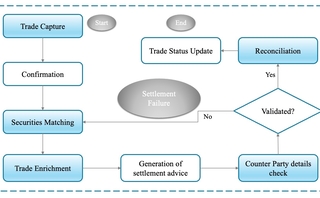Connective tissue: S&P's InvestorAccess enables secondary market-like trading of primary issues
Through a combination of its own technology and partnerships with fixed-income mainstays Bloomberg and Tradeweb, S&P is looking to create end-to-end workflows to simplify trading of primary bond issues for both buy-side and sell-side firms.

Just like in the animal kingdom, different markets evolve at different rates. As a result, certain asset classes benefit from technology that has not yet reached others. For example, bonds pre-date equities by hundreds of years, but equity markets are much more advanced in terms of how they leverage technology than the collection of asset classes broadly classified as fixed income.
In the corporate bond market, these differences become even clearer when looking at the primary and secondary markets. The primary market is where securities originate, while in the secondary market, previously issued securities and bonds float between buyers and sellers. The secondary corporate bond market has well-established platforms like Tradeweb and MarketAxess for market liquidity, but the primary market lacks similar options. From a risk perspective, the primary market remains the most efficient way to get risk into a portfolio by buying in bigger sizes and at more attractive levels.
“Sell-side firms often have different ways of interacting with the buy side, including idiosyncratic workflows that create inefficiencies. Buy sides were unable to electronically track upcoming deals. Historically, this has created challenges for electronic connections between both the sell side and buy side,” says Chris Sztam, managing director of the global markets group at S&P Global Market Intelligence.
As a remedy for this lack of electronic connection, S&P’s InvestorAccess buy-side platform allows market participants to trade primary markets in almost the same way they trade secondary markets—and, crucially, via the same existing order and execution management systems already used by firms for trading secondary markets.
InvestorAccess originated at Ipreo, which was acquired by IHS Markit in 2018. When S&P Global merged with IHS Markit two years ago, the combined vendor further enhanced the product. Today, InvestorAccess provides a technology platform for the sell side to communicate electronically on new opportunities and present them to the buy side. The platform then facilitates new issue allocations and full automation to order management systems used by firms on both the buy side and sell side. It currently supports primary issuance in US equities, US municipal bonds, and global fixed income.
The platform is built to be modular, so depending on a firm’s specific needs in the workflow, they can choose to connect to different capabilities individually or as a whole platform.
A CLOB for primary markets
Last month, S&P announced the integration of InvestorAccess and Bloomberg’s TSOX execution management system (EMS) to streamline the syndicated primary bond workflow. Mutual clients of both can stage orders from their order management system (OMS) into TSOX, connecting to InvestorAccess and the syndicate book, which will send final allocations back to the OMS.
Elona Tepshi, global head of execution management systems at Bloomberg, likens InvestorAccess to a central limit order book (CLOB). “Think of InvestorAccess as almost like a CLOB. The syndicate book is basically where the dealers are getting orders from all these clients. And now their book is getting bigger and bigger as the day goes by because they’re getting orders and interest from different users,” Tepshi says.
InvestorAccess enables dealers to monitor that level of interest live throughout the day, something that in the past would have been done by phone, due to the manual nature of the workflow.
In primary issuance, a lack of an identifier contributed to the process being manual, Tepshi says. Therefore, to make this end-to-end workflow seamless, the Financial Industry Global Identifier (Figi) that is owned by the non-profit Object Management Group and issued by Bloomberg, comes into play.
“The way that an EMS works is it recognizes a security by the market identifier. It could be a Cusip, Isin, Sedol, etc.,” Tepshi says. “However, the market did not have an identifier for new issues. The electrification of the new issue, or the primary market, has been possible because of the structuring of deal creation using the Figi.”
Figi is open source, so anyone can access it. When an order is staged, it is assigned a Figi, but by the time the new issues are allocated, that identifier will be populated with another. “By us creating these feeds to provide Figis to the other systems and having it be open-source means that market participants can access it themselves. It absolutely creates the standardization of primary market securities in the entire market,” Tepshi says.
The buy side has been waiting for this end-to-end workflow, says Nick Hall, head of fixed-income primary markets at Bloomberg. “What the buy side have been waiting for is for the market to deliver a solution that connects their OMS platform all the way through to the bank’s book-build platforms,” Hall says. “And the TSOX connection to S&P’s InvestorAccess is the first time anyone has ever done that in the primary market.”
Due to the previously manual nature of the workflow, executing primary markets trades like this in the past would have involved re-keying in orders, a process that can be prone to mistakes due to the complexity of the orders being placed. “It’s not simply a case of ‘I want 10 million of this security.’ It’s ‘I’ll have 5 million of this security if it’s priced at X, I’ll have 3 million if it’s priced at Y, and 2 million if it’s priced at Z.’ They’re layered orders,” Hall says.
It also moves some communication off the phone. “They’re not having to bother spending all that time on admin because the orders are flowing straight through. Therefore, they can have a conversation about other things about like the quality of the deal,” he says.
Hall says developments in recent years to try and tackle the problems in primary markets had been met with limited success. “From the buy-side perspective, they still don’t want to have to go to another system or website and key their order in there because it’s an extra system to onboard,” he says.
InvestorAccess is also working with Tradeweb to provide connectivity between primary and secondary markets in European credit, covered, sovereign, supranational and agency bonds. Tradeweb has integrated InvestorAccess into its user interface so clients will be able to monitor new deals and enter orders in the same environment they use to trade secondary markets.
The integration also includes OMS connectivity, says Chioma Okoye, managing director for corporate development at Tradeweb. “For those who wanted to go that extra step, they could work with us to make it possible for their allocations on new issue deals to be pushed directly into their order management systems using the existing connectivity they already had from the secondary markets trading they do with us.”
The post-trade capabilities are still in development at Tradeweb with a few clients in testing. Okoye says extending the workflows that exist in secondary markets to primary markets is logical. “If you can speed up the process of the new issue lifecycle, and then get into the ability to trade in secondary much more quickly, much more smoothly, with fewer errors and with greater efficiency, that is a positive place to be,” Okoye says.
In an ecosystem where firms use different platforms and won’t onboard new ones, S&P is looking to make InvestorAccess vendor-agnostic in the future.
Carl James, head of fixed income at S&P Global, says more partnerships will take shape and he sees it as a key part of InvestorAccess’ offering. “If someone chooses to sign up to a Charles River, or whatever OMS it is, it’s like ‘Great, we have a relationship with them,’” James says.
TSOX, for its part, currently connects into 95 order management systems.
An interoperable approach to technology in this space is what will work best with what firms have adopted internally, Sztam says. “There are varied vendors, ways of working, differing business models within our client segments that are often not consistent from one market participant to the next,” he says. “This requires us to have a way to allow for these varied approaches to work together, requiring a need for interoperability and flexible technology solutions among market participants.”
Only users who have a paid subscription or are part of a corporate subscription are able to print or copy content.
To access these options, along with all other subscription benefits, please contact info@waterstechnology.com or view our subscription options here: http://subscriptions.waterstechnology.com/subscribe
You are currently unable to print this content. Please contact info@waterstechnology.com to find out more.
You are currently unable to copy this content. Please contact info@waterstechnology.com to find out more.
Copyright Infopro Digital Limited. All rights reserved.
You may share this content using our article tools. Printing this content is for the sole use of the Authorised User (named subscriber), as outlined in our terms and conditions - https://www.infopro-insight.com/terms-conditions/insight-subscriptions/
If you would like to purchase additional rights please email info@waterstechnology.com
Copyright Infopro Digital Limited. All rights reserved.
You may share this content using our article tools. Copying this content is for the sole use of the Authorised User (named subscriber), as outlined in our terms and conditions - https://www.infopro-insight.com/terms-conditions/insight-subscriptions/
If you would like to purchase additional rights please email info@waterstechnology.com
More on Trading Tech
For MarketAxess, portfolio trading buoys flat revenue in Q3
The vendor is betting on new platforms like X-Pro and Adaptive Auto-X, which helped forge a record quarter for platform usage.
Quants look to language models to predict market impact
Oxford-Man Institute says LLM-type engine that ‘reads’ order-book messages could help improve execution
JP Morgan pulls plug on deep learning model for FX algos
The bank has turned to less complex models that are easier to explain to clients.
Nasdaq says SaaS business now makes up 37% of revenues
The exchange operator’s Q3 earnings bring the Adenza and Verafin acquisitions center stage.
Harnessing generative AI to address security settlement challenges
A new paper from IBM researchers explores settlement challenges and looks at how generative AI can, among other things, identify the underlying cause of an issue and rectify the errors.
The causal AI wave could be the next to hit
As LLMs and generative AI grab headlines, another AI subset is gaining ground—and it might solve what generative AI can’t.
Waters Wrap: Operational efficiency and managed services—a stronger connection
As cloud, AI, open-source, APIs and other technologies evolve, Anthony says the choice to buy or build is rapidly evolving for chief operating officers, too.
BlackRock forecasts return to fixed income amid efforts to electronify market
The world's largest asset manager expects bond markets to make headway once rates settle.








